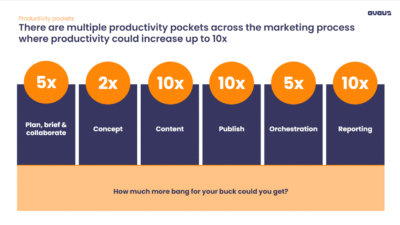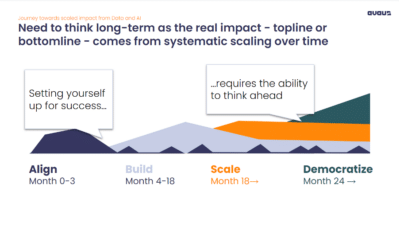Being a CMO has never been more challenging. With rapid changes and increasing pressures, many CMOs might feel overwhelmed, even fearful, as they look ahead to 2024. Many marketing organizations, having already faced the need for reorientation in 2023, underscore the importance of a solid plan. This guide focuses on three critical areas to ensure that your role as a CMO is not just secure but successful.
While business as usual takes up most of your capacity and the time of your team, you need to address the strategic shifts head-on. With these three transformational areas covered, you can trust that you are not only delivering in the short term, but building for the long term – something that your CEO and board will want to ensure as the market is shaky, AI advancements (but also ethical considerations) are discussed in every board meeting, and the changing legislative environment is creating traps for marketing organizations to step into.
1) First-party data and the cookie death
The most urgent strategic shift to adapt to is the decline of third-party cookies. As of 4th of January 2024, Google has started to limit the use of third-party cookies in Google Chrome. This will mean less data to steer your advertising on, less transparency for ad spend and fewer targeting possibilities, possibly driving up the cost of advertising and surely creating insecurity in reporting an results follow-up.
It’s not just a technical shift; it’s a fundamental change in how marketers collect and use data. This change can be daunting, but it’s also a chance to innovate and take control of your data strategy.
Concrete actions suggested:
- Own your data: Take control of ALL of your data sources, including for instance third-party advertising platforms and tools typically used by your agencies or partners. Check your consent and privacy frameworks and build a solid and compliant framework for the future use of your data. Many companies forget to carefully define their privacy guidelines early on, and struggle many years down the road when data you have can’t be compliantly used.
- Strategize for the future: Develop a comprehensive, evolving data strategy for long-term benefits. You should at least plan for three horizons of data use (data you can use today, 12 months from now and 3-5 years from now). Explore also possible new avenues brought by improved first-party data capabilities, such as venturing into the growing domain of retail media.
- Establish a first-party database: Prioritize building a first-party database – sooner rather than later. This is often called a Customer Data Platform or CDP. You can do this in many ways, but our recommendation is to start by creating a customer profile in your existing (cloud) data warehouse and activating first use cases with that capability, before adding more complexity. This will help you recognize problems with data, consent and activation platforms early – not only 12-18 months down the road once you have evaluated, contracted and implemented a commercial CDP.
2) Productivity: doing more with less
This is about maximizing productivity, especially critical in a recession scenario. As a CMO, you’re expected to deliver more revenue with fewer resources. In a normal recession scenario, you would be asked to use the cheesegrater on your headcounts and media spend. But this year is special, as every CEO/CFO and board have been reading all about how marketing and sales are the areas where productivity improvements from AI will be the fastest and most visible.
The trick for you is to be analytical and decisive on how you can improve productivity in the best way using all the new technical potential. Remember: this change requires diligent leadership – nothing that procurement of a tool or platform will solve for you.
Concrete actions suggested:
- Understand what is, or will be, possible: Discover actionable strategies to amplify your marketing productivity. The 10x Marketing Productivity with AI webinar is a must-watch for concrete insights that drive efficiency.
- Audit your productivity and create a business case: Undertake a productivity audit (if you are interested, Avaus has a free approach to get you started). Identify focus areas for improvement and develop a supporting business case. Use this to showcase to your CFO/CEO and find a suitable target level for productivity increases over the coming 2-3 years. Don’t promise short-term miracles, but plan for small demonstrations so that the big picture is feasible within the year 2024.
- Revise vendor contracts: Reevaluate your contracts to shift towards outcome-based agreements, incentivizing productivity. An easy way is to let your agencies know that you will be expecting a significant increase in output (our recommendation is a Year-on-Year productivity improvement of 40-100%) with the same budgets in 2025 and that they need to start preparing. Consider involving new partners to support this transition as most traditional agencies do not have the technical expertise.

Typical productivity pockets that data, AI and automation can help you address. Download the Webinar materials to find out more.
3) Begin your AI journey
Embracing AI is not just about keeping up with trends; it’s about keeping your license to operate in a rapidly evolving digital landscape. This journey requires a systematic approach, identifying impactful use cases and auditing your current capabilities while creating a plan for which approach and speed you will address the potential ahead.
One thing is for sure – if you by the end of 2024, don’t have a solid and analytical plan and haven’t started to take concrete actions, displaying clear results, you might be in the risk zone for being replaced. No marketing organization will be able to compete if not utilizing the new technologies available.
Concrete actions suggested:
- Augment your organization with experts: this is not an area where you should solely rely on your organization learning fast enough. Ensure that you have support to choose the right path while limiting risks connected to personnel turnover or simply not seeing the entire picture. The decisions you have ahead of you are some of the most complex and difficult strategic decisions your organization has ever faced – do not assume that you have all competence inhouse (if you do, and you are either working at Google, Meta, Amazon etc. or you have a problem with confidence bias called the Dunning Kruger effect).
- Define your AI adoption path: Decide whether to be an early adopter or a more cautious pathfinder. The key is to start moving and keep learning, whatever the speed.
- Focus on short-term learnings and results: Most useful use cases are likely within “classic AI” used on your existing customers and marketing/sales processes. Another area is using generative AI for text and image creation (mainly by using built-in features in your existing platforms such as Firefly in Adobe Photoshop).
- Join industry events to educate yourself: AI: Beyond the Hype is the largest industry event focused on AI in marketing, sales and service in the Nordics, with pragmatic advice, peer inspiration and thought leaders sharing their best practices for your benefit. Sign up now for a day of valuable, no-nonsense content.

Significant business impact from utilizing Data, AI and Automation will come over time but will require that you think ahead already today
Final thoughts on your path to navigating 2024 successfully
Having these three areas covered during 2024 can be seen as a must-have for any enterprise marketing organization. While it might sound like a lot, it will not require massive investments – especially if you use an external partner to support your process, involving your team in the way that makes the most sense to your particular situation. Most organizations need a year to prepare business cases, resourcing decisions and investments for the changes ahead – use 2024 as the year where you lay the foundation for success ahead.
The lightest possible approach is to use a partner to support you in creating actionable plans and first results in these areas (working closely with also education and change management). If you want a more transformative approach, you launch a marketing transformation program and heavily involve the marketing organization as well as other stakeholders already during the planning process.
Whichever approach you choose, by focusing on these three strategic areas alongside your “business as usual”, you will be able to position yourself not just to navigate the challenges of 2024 but to emerge as a leader who is prepared for the future.
If you want to ensure you are tackling these challenges with the help of industry experts, reach out to your local Avaus contact!
We support organizations in a range of ways, ranging from minimum/light-touch “pathfinder” advisory to joining your team for a long-term transformational journey.
 Emma Storbacka, CEO, emma.storbacka@avaus.com
Emma Storbacka, CEO, emma.storbacka@avaus.com
 Johanna Andrén, Head of Growth, johanna.andren@avaus.com
Johanna Andrén, Head of Growth, johanna.andren@avaus.com
 Anna Hakkarainen, Head of Strategy & Growth, anna.hakkarainen@avaus.com
Anna Hakkarainen, Head of Strategy & Growth, anna.hakkarainen@avaus.com